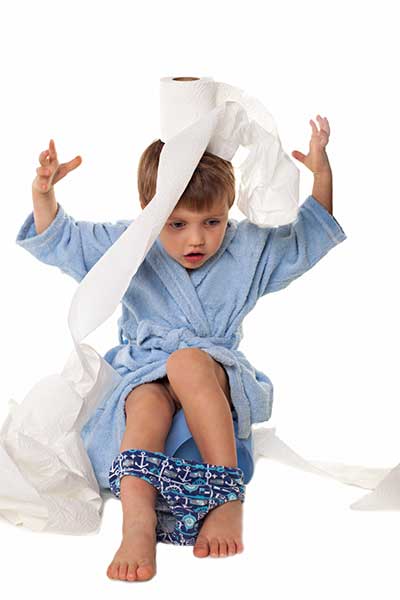The first goal of discipline is to protect your child from danger. Another important goal is to teach your child an understanding of right from wrong. Reasonable limit setting keeps us from raising a “spoiled” child. To teach respect for the rights of others, first teach your child to respect your rights. Begin external controls by 6 months of age. Children don’t start to develop internal controls (self-control) until 3 or 4 years of age. They continue to need external controls, in gradually decreasing amounts, through adolescence.

Guidelines for setting rules 🔗
-
Begin discipline after 6 months of age. Young infants don’t need any discipline. By the time they crawl, all children need rules for their safety.
-
Express each misbehavior as a clear and concrete rule. Examples of clear rules are “Don’t push your brother” and “Don’t interrupt me on the telephone.”
-
Also state the acceptable or appropriate behavior. Your child needs to know what is expected of him. Examples are “Play with your brother,” “Look at books when I’m on the telephone,” or “Walk, don’t run.”
-
Ignore unimportant or irrelevant misbehavior. Avoid constant criticism. Behavior such as swinging the legs, poor table manners, or normal negativism is unimportant during the early years.
-
Use rules that are fair and attainable. A child should not be punished for behavior that is part of normal emotional development, such as thumb sucking, fears of being separated from the parents, and toilet-training accidents.
-
Concentrate on 2 or 3 rules initially. Give highest priority to issues of safety, such as not running into the street, and to the prevention of harm to others. Of next importance is behavior that damages property. Then come all the annoying behavior traits that wear you down (such as tantrums or whining).
-
Avoid trying to change “no-win” behavior through punishment. Examples are wetting pants, pulling their own hair, thumb sucking, body rocking, masturbation, not eating enough, not going to sleep, and refusal to complete schoolwork. The first step in resolving such a power struggle is to withdraw from the conflict and stop punishing your child for the misbehavior. Then give your child positive feedback when he behaves as you’d like.
8 Apply the rules consistently. After the parents agree on the rules, it may be helpful to write them down and post them.
Discipline Techniques (including consequences) 🔗
Techniques to use for different ages are summarized here. The techniques mentioned here are further described after this list:
- From birth to 6 months: no discipline necessary
- From 6 months to 3 years: structuring the home environment, distracting, ignoring, verbal and nonverbal disapproval, physically moving or escorting, and temporary time-out
- From 3 years to 5 years: the preceding techniques (especially temporary time-out) plus natural consequences, restricting places where the child can misbehave, and logical consequences
- From 5 years to adolescence: the preceding techniques plus delay of a privilege, “I” messages, and negotiation via family conferences
- Adolescence: logical consequences, “I” messages, and family conferences about house rules; time-out and manual guidance (see below) can be discontinued
- Structure the home environment. You can change your child’s surroundings so that an object or situation that could cause a problem is eliminated. Examples are installing gates, locks, and fences to protect the child.
- Distracting your child from misbehavior. Distracting a young child from temptation by attracting his attention to something else is especially helpful when the child is in someone else’s house or a store (e.g., distract with toys, food, or games).
- Ignore the misbehavior. Ignoring helps to stop unacceptable behavior that is harmless-such as tantrums, sulking, whining, quarreling, or interrupting.
- Use verbal and nonverbal disapproval. Mild disapproval is often all that is required to stop a young child’s misbehavior. Get close to your child, get eye contact, look stern, and give a brief “no” or “stop.”
- Physically move or escort (“manual guidance”). Manual guidance means that you move a child from one place to another (e.g., to bed, bath, car, or time-out chair) against his will and help him as much as needed (e.g., carrying).
- Use temporary time-out or social isolation. Time- out is the most effective discipline technique available to parents. Time-out is used to interrupt unacceptable behavior by removing the child from the scene to a boring place, such as a playpen, corner of a room, chair, or bedroom. Time-outs should last about 1 minute per year of age and not more than 5 minutes.
Restrict places where a child can misbehave. This technique is especially helpful for behavior problems that can’t be eliminated. Allowing nose picking and masturbation in your child’s room prevents an unnecessary power struggle.
-
Use natural consequences. Your child can learn good behavior from the natural laws of the physical world; for example, not dressing properly for the weather means your child will be cold or wet, or breaking a toy means it isn’t fun to play with anymore.
-
Use logical consequences. These should be logically related to the misbehavior, making your child accountable for his problems and decisions. Many logical consequences are simply the temporary removal of a possession or privilege if your child has misused the object or right.
-
Delay a privilege. Examples of work before play are “After you clean your room, you can go out and play” or “When you finish your homework, you can watch television.”
-
Use “I” messages. When your child misbehaves, tell your child how you feel. Say, “I am upset when you do such and such.” Your child is more likely to listen to this than a message that starts with “you.” “You” messages usually trigger a defensive reaction.
-
Negotiate and hold family conferences. As children become older they need more communication and discussion with their parents about problems. A parent can begin such a conversation by saying, “We need to change these things. What are some ways we could handle this? What do you think would be fair?”
-
Temporarily discontinue any physical punishment. Most out-of-control children are already too aggressive. Physical punishment teaches them that it’s acceptable to be aggressive (e.g., hit or hurt someone else) to solve problems.
-
Discontinue any yelling. Yelling and screaming teach your child to yell back; you are thereby legitimizing shouting matches. Your child will respond better in the long run to a pleasant tone’ of voice and words of diplomacy.
-
Don’t forget to reward acceptable(desired) behaviors. Don’t take good behavior for granted. Watch for behavior you like, and then praise your child. At these times, move close to your child, look at him, smile, and be affectionate. A parent’s attention is the favorite reward of most children.
Guidelines for giving 🔗
Consequences (punishments) 🔗
-
Be unambivalent. Mean what you say and follow through.
-
Correct with love. Talk to your child the way you want people to talk to you. Avoid yelling or using a disrespectful tone of voice. Correct your child in a kind way. Sometimes begin your correction with “I’m sorry I can’t let you. . .”
-
Apply the consequence immediately. Delayed punishments are less effective because young children forget why they are being punished. Punishment should occur very soon after the misbehavior and be administered by the adult who witnessed the misdeed.
-
Make a one-sentence comment about the rule when you punish your child. Also restate the preferred behavior, but avoid making a long speech.
-
Ignore your child’s arguments while you are correcting him. This is the child’s way of delaying punishment. Have a discussion with your child at a later, more pleasant time.
-
Make the punishment brief. Take toys out of circulation for no more than 1 or 2 days. Time- outs should last no longer than 1 minute per year of the child’s age and 5 minutes maximum.
-
Follow the consequence with love and trust. Welcome your child back into the family circle and do not comment on the previous misbehavior or require an apology for it.
-
Direct the punishment against the misbehavior, not the person. Avoid degrading comments such as “You never do anything right.”
When to seek professional help 🔗
- Your child’s misbehavior is dangerous.
- The instances of misbehavior seem too numerous to count.
- Your child is also having behavior problems at school.
- Your child doesn’t seem to have many good points.
- Your child seems depressed.
- The parents can’t agree on discipline.
- You can’t give up physical punishment. (Note: Call immediately if you are afraid you might hurt your child.)
- The misbehavior does not improve after 1 month of using this approach.


